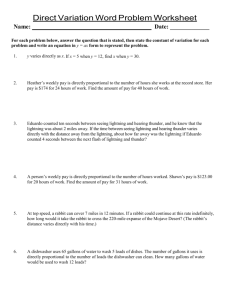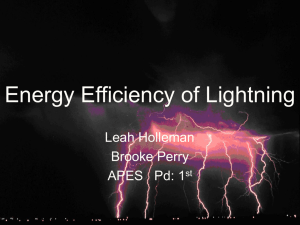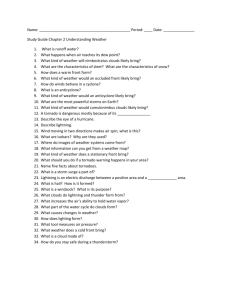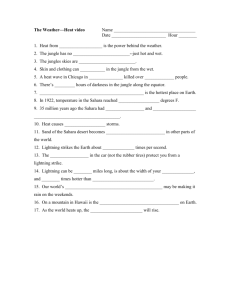GR4 WK10 6.1.1
advertisement
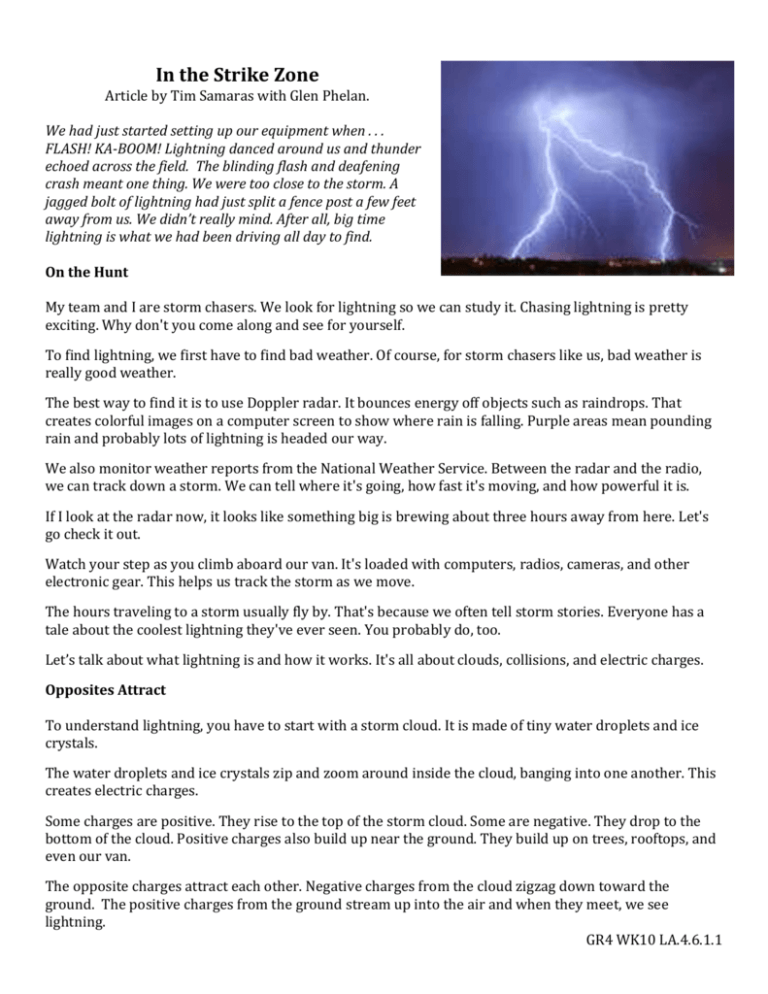
In the Strike Zone Article by Tim Samaras with Glen Phelan. We had just started setting up our equipment when . . . FLASH! KA-BOOM! Lightning danced around us and thunder echoed across the field. The blinding flash and deafening crash meant one thing. We were too close to the storm. A jagged bolt of lightning had just split a fence post a few feet away from us. We didn’t really mind. After all, big time lightning is what we had been driving all day to find. On the Hunt My team and I are storm chasers. We look for lightning so we can study it. Chasing lightning is pretty exciting. Why don't you come along and see for yourself. To find lightning, we first have to find bad weather. Of course, for storm chasers like us, bad weather is really good weather. The best way to find it is to use Doppler radar. It bounces energy off objects such as raindrops. That creates colorful images on a computer screen to show where rain is falling. Purple areas mean pounding rain and probably lots of lightning is headed our way. We also monitor weather reports from the National Weather Service. Between the radar and the radio, we can track down a storm. We can tell where it's going, how fast it's moving, and how powerful it is. If I look at the radar now, it looks like something big is brewing about three hours away from here. Let's go check it out. Watch your step as you climb aboard our van. It's loaded with computers, radios, cameras, and other electronic gear. This helps us track the storm as we move. The hours traveling to a storm usually fly by. That's because we often tell storm stories. Everyone has a tale about the coolest lightning they've ever seen. You probably do, too. Let’s talk about what lightning is and how it works. It's all about clouds, collisions, and electric charges. Opposites Attract To understand lightning, you have to start with a storm cloud. It is made of tiny water droplets and ice crystals. The water droplets and ice crystals zip and zoom around inside the cloud, banging into one another. This creates electric charges. Some charges are positive. They rise to the top of the storm cloud. Some are negative. They drop to the bottom of the cloud. Positive charges also build up near the ground. They build up on trees, rooftops, and even our van. The opposite charges attract each other. Negative charges from the cloud zigzag down toward the ground. The positive charges from the ground stream up into the air and when they meet, we see lightning. GR4 WK10 LA.4.6.1.1 Lightning Bolts It may look like lightning strikes down from the cloud. In fact, the streak of lightning you see is the return stroke. It's going up to the cloud. You can't tell because it happens so fast. The most common type of lightning is called intracloud lightning. It blankets the sky with a brilliant flash of white. You can't see the lightning bolt. It is hidden. The lightning bolt arcs inside a cloud. From the ground, it looks like the cloud flickers. When lightning leaps across a gap of clear air between two different clouds, we call that intercloud lightning. Then there's cloud-to-ground lightning. Forks and streaks of lightning reach between the cloud and ground. That's the most dangerous form. It is also the kind we know the most about. Lighting up the Sky Finally, we've made it to the storm. We pull off the side of the road and pile out. Wide-open plains stretch all around. Dark gray clouds gather just ahead of us. It's a monster storm! In a few minutes, the sky comes alive with lightning. Our team reacts with cries of "Whoa!" and "Did you see that?" Each lightning bolt is followed by a loud Crack! I'm not surprised, but the sound still makes me shudder. Lightning is often followed by thunder. A lightning bolt instantly heats the nearby air to temperatures hotter than the surface of the sun. The sizzling hot air usually has no time to expand when the lightning strikes. So it just explodes outward with a loud boom. We call that sound thunder. Lightning and thunder happen at just about the same time. However, light travels a lot faster than sound. That's why we see lightning before we hear the thunder. We don't always hear thunder when we see lightning. Sometimes the thunder is too far away. Risky But Not Reckless As you can guess, there's lots of adventure in chasing lightning. There's some danger, too. Most lightning happens at the beginning of a storm. So we try to stay in front of the storm to catch the most action. Of course, that puts us right in the storm's path. If the storm moves fast, we might quickly find ourselves surrounded by lightning. When that happens, we jump in our vehicles and drive to safety. Lightning is nothing to mess around with. A direct hit can kill. We're fairly safe in our vehicles. If lightning strikes one, the electricity travels through the metal to the ground. It might blow out a tire. We're okay as long as we don't touch the metal. Sometimes there's no warning lightning is coming. It can seem to strike from out of nowhere. That's because a lightning bolt can travel 190 kilometers (118 miles) from the cloud where it started. So the sky may be blue above us, but we could still get zapped by lightning. It's rare, but it shows how unpredictable lightning is. GR4 WK10 LA.4.6.1.1 Weird Lightning As if lightning weren't strange enough, it does some things that are downright weird. Since ancient times, people have reported seeing glowing, basketball-size balls of light floating around after lightning strikes nearby. This is called ball lightning. The yellow or orange balls have been reported to move outside, through buildings, and even on airplanes. Then they disappear, sometimes with a small clap of thunder. No clear photos have been taken of ball lightning. Yet there have been enough reports of it that most scientists think it is real, even if they can't explain it. Lightning can also leave its mark. Its heat can shatter a tree or leave dark burns on metal poles. It can make sculptures, too. When lightning strikes sand, its heat fuses the sand grains together. The result is a rocky tube in the shape of the lightning bolt. Looking for Answers Lightning has left its mark on me, too, but in a good way. People often ask me, "Why do you chase lightning?" If you ever watched a thunderstorm, you already know part of the answer. You have witnessed the power of this force of nature. It's thrilling. The bigger thrill for me, though, is exploring the unknown. There's so much about lightning we don't know. Finding the answers to these and other questions will help us all stay safer during storms. For now, I'm heading back into this storm. There's still a lot for me and my team to learn. GR4 WK10 LA.4.6.1.1 1. The author includes the italicized introduction to A. B. C. D. suggest searching for lightning is difficult. encourage readers to be safe during a storm. describe what lightning looks and sounds like. explain to readers why fences are easily broken. 2. Under which heading would you MOST LIKELY find information on how to locate a storm? A. On the Hunt B. Lightning Bolts C. Lighting up The Sky D. Risky But Not Reckless 3. Which sentence from the article BEST explains the second photograph? A. Its heat can shatter a tree or leave dark burns on metal poles. B. When lightning strikes sand, its heat fuses the sand grains together. C. So the sky may be blue above us, but we could still get zapped by lightning. D. As if lightning weren’t strange enough, it does some things that are downright weird. 4. What is the purpose of the heading “Opposites Attract”? A. to prove why lightning comes from storm clouds. B. to list all of the different types of lightning that can form. C. to provide an example of how water droplets and ice crystals create lightning. D. to explain how the positive and negative charges come together to form lightning. 5. The first photograph is an example of which type of lightning? A. B. C. D. ball lightning tube lightning intracloud lightning cloud-to-ground lightning GR4 WK10 LA.4.6.1.1 6. Read the sentence from the article. It’s rare, but it shows how unpredictable lightning is. Which word has the same base word as the word unpredictable? A. prediction B. preview C. understandable D. unpleasant 7. Which detail from the article helps show why lightning is seen before thunder is heard? A. We call that sound thunder. B. However, light travels a lot faster than sound. C. Most lightning happens at the beginning of a storm. D. Lightning and thunder happen at just about the same time. 8. Which statement from the article BEST explains how the author feels about lightning? A. My team and I are storm chasers. B. Chasing lightning is pretty exciting. C. For now, I’m heading back into this storm. D. To find lightning, we first have to find bad weather. 9. The section “Risky But Not Reckless” is included to A. B. C. D. prove that studying storms is expensive. suggest that chasing lightning is a deadly activity. describe that storm chasing is predictable and slow. explain that even though lightning is dangerous they are safe. 10. How is cloud-to-ground lightning DIFFERENT from intracloud lightning? A. B. C. D. Intracloud lightning is dangerous, while cloud-to-ground lightning is not. Intracloud lightning disappears, while cloud to ground lightning flickers behind a cloud. Intracloud lightning remains hidden, while cloud-to-ground lightning reaches the ground. Intracloud lightning is made of water droplets, while cloud-to-ground lightning is made of ice crystals. GR4 WK10 LA.4.6.1.1 Answer Key: 1. Correct Answer C, DOK 2 2. Correct Answer A, DOK 1 3. Correct Answer A, DOK 2 4. Correct Answer D, DOK 2 5. Correct Answer D, DOK 2 6. Correct Answer A, DOK 1 7. Correct Answer B, DOK 1 8. Correct Answer B, DOK 2 9. Correct Answer D, DOK 3 10. Correct Answer C, DOK 3 GR4 WK10 LA.4.6.1.1




